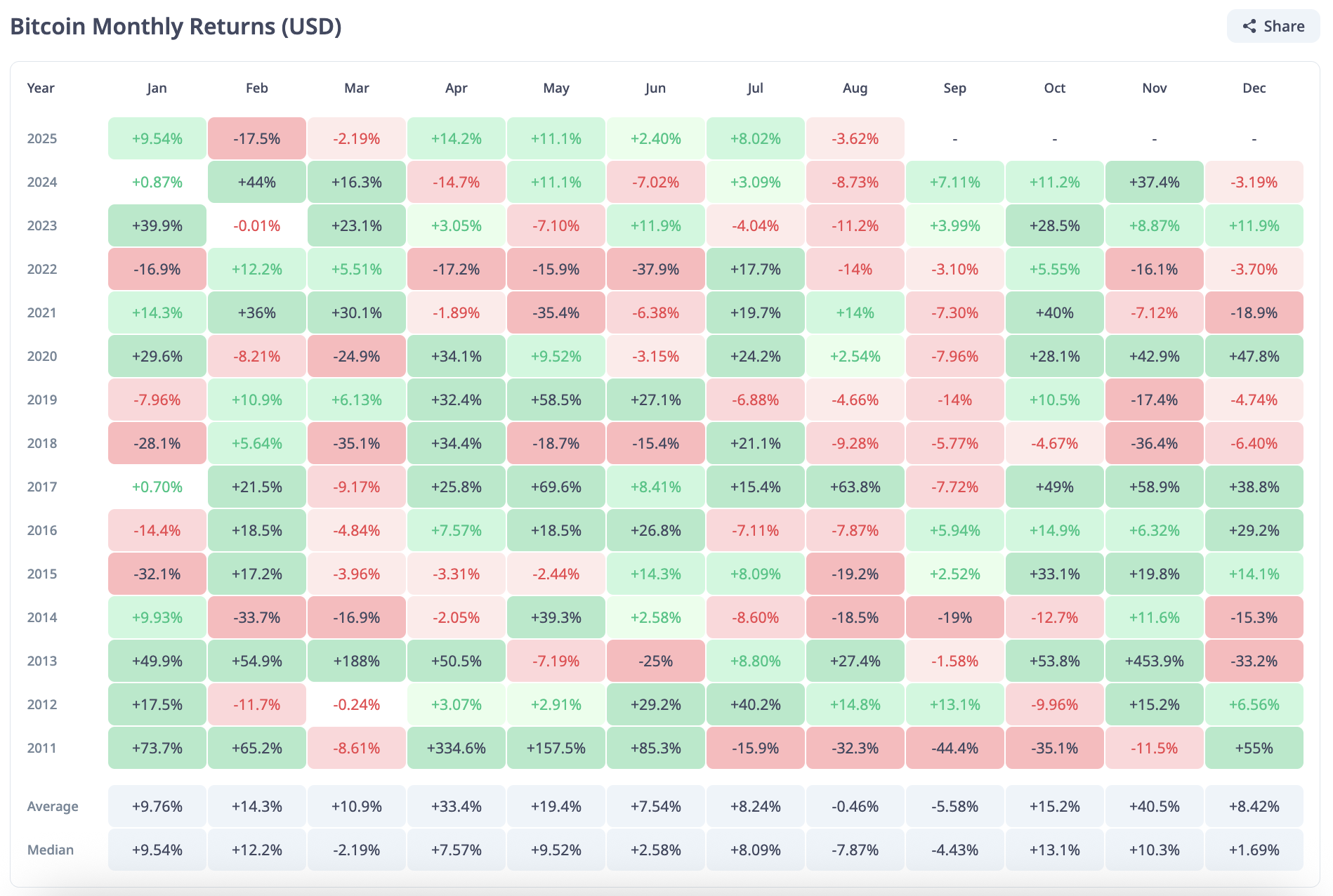September has historically been the weakest month for Bitcoin, averaging a decline around -5.6% and a median near -4.4%; traders should view September as a higher-risk period for BTC entries and consider risk management or phased buying strategies.
-
September average return: -5.58% (median -4.43%)
-
September often shows lower liquidity and fading summer rallies, increasing downside risk.
-
October historically flips to stronger returns, averaging +15.2% in past cycles.
September Bitcoin performance: historical returns show consistent weakness for BTC—read strategic steps to manage risk this month. Learn more with COINOTAG insights.
What is September’s historical performance for Bitcoin?
September Bitcoin performance shows a persistent pattern of negative returns: across more than a decade, the month averages a decline of about -5.58% with a median of -4.43%. This makes September one of the weakest months on the BTC calendar and a higher-risk window for new positions.
Why does Bitcoin often fall in September?
Several structural and seasonal factors compress BTC performance in September. Liquidity typically thins after summer, institutional flows can slow, and macro event clustering (earnings, policy decisions) increases volatility. Historically, these conditions combine to cause sharper downside moves in September.

Source: CryptoRank
Bitcoin price history leaves little debate — September has almost never been the right month to make optimistic investment decisions with the main cryptocurrency. Across more than a decade of data, this exact month stands out as the weakest point on the calendar, carrying an average return of -5.58% and a median of -4.43%.
Red runs across cycles: bull markets, bear markets, sideways years; September has usually been the setback. August has often been weak too, creating a bearish sequence in BTC seasonality that traders should note.
This dynamic is evident in the current BTC chart set-up. A pullback that began after July’s climb above $120,000 lost momentum, and August posted a 3.9% loss. Rolling into historically weak September raises downside risk for bullish traders.
How stubborn the pattern is can be seen in specific years: September 2022 closed down 3.1%, 2021 fell 7.3%, 2018 sank 5.7%, and 2014 plunged 19%. The few green Septembers (e.g., +5.9% in 2016, +2.5% in 2015) remain exceptions rather than a reliable trend.
When has September deviated from the pattern?
September has occasionally produced positive returns, but these are rare and usually occur alongside broader bullish macro conditions. Notable deviations occurred in mid-cycle years when momentum from earlier quarters carried through; nonetheless, the historical average remains negative.
How should investors approach September for BTC?
Adopt measured, risk-aware tactics. Consider dollar-cost averaging, setting wider stop-losses, or reducing position size ahead of September. Use short timeframes for trade entries and preserve capital for potential October recoveries, which historically show stronger gains.
What does the month-by-month comparison show?
Comparing September to October highlights the seasonal contrast: September averages negative returns while October frequently posts outsized positive performance. Traders can use month-to-month averages to time exposures around these tendencies.
| Month | Average Return | Median Return |
|---|---|---|
| September | -5.58% | -4.43% |
| October | +15.2% | +10.1% |
Frequently Asked Questions
Is September usually a bad month for Bitcoin?
Yes. September is historically one of Bitcoin’s worst-performing months, averaging about -5.58% and often exhibiting reduced liquidity and higher downside risk.
Should I sell Bitcoin before September?
Not necessarily. Decisions should depend on investment horizon and risk tolerance. Consider reducing exposure if you are short-term oriented, or use phased buying to mitigate seasonal drawdowns.
How often does September flip to positive returns?
Only in a minority of years — positive Septembers occur but are exceptions. Relying on such flips is risky without broader bullish signals.
Key Takeaways
- Seasonal weakness: September shows a historical average decline of -5.58% for Bitcoin.
- Risk management: Use phased entries, sizing discipline, and protective stops during September.
- Recovery potential: October has historically delivered strong recoveries, averaging +15.2%.
Conclusion
Historical data confirms September Bitcoin performance is statistically weaker than most months, driven by liquidity and seasonal cycle factors. Investors should integrate this seasonality into position sizing and timing, while monitoring macro and on-chain signals for any deviation from the trend. COINOTAG will continue tracking monthly performance and providing updates.
